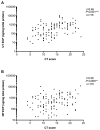A prospective analysis evaluating tissue biopsy location and its clinical relevance in chronic rhinosinusitis with nasal polyps
- PMID: 28863237
- PMCID: PMC5966315
- DOI: 10.1002/alr.22005
A prospective analysis evaluating tissue biopsy location and its clinical relevance in chronic rhinosinusitis with nasal polyps
Abstract
Background: Chronic rhinosinusitis with nasal polyps (CRSwNP) has a high propensity for recurrence. Studies suggest that eosinophilia influences disease severity and surgical outcomes, but the selection of sinonasal site for measuring eosinophilia has not been examined. The aim of this study was to investigate how region-specific tissue eosinophilia affects radiographic severity, comorbidity prevalence, and polyp recurrence risk following sinus surgery.
Methods: Eosinophil cationic protein (ECP) levels in uncinate tissue (UT) and nasal polyp (NP) homogenates from 116 CRSwNP patients were measured using enzyme-linked immunosorbent assay (ELISA). Clinical history, radiographic severity, and time to polyp recurrence were obtained from electronic health records. The correlations between baseline Lund-Mackay scores and comorbidities were compared between UT and NP ECP levels. Cox regression and Kaplan-Meier analysis were then performed to assess whether UT or NP ECP better predicted recurrence. Censoring occurred at 4 years or at last follow-up if there was no endoscopic diagnosis of recurrent polyps.
Results: Lund-Mackay scores were significantly correlated with UT and NP ECP (r = 0.46 and 0.26 respectively, p < 0.05). UT but not NP ECP was significantly higher in patients with asthma (p < 0.01) and aspirin-exacerbated respiratory disease (AERD) (p < 0.05). Polyp recurrence risk was only significantly higher for patients with eosinophilic UT tissue (hazard ratio [HR] = 2.84, p = 0.025). When measured in NP, eosinophilia did not predict recurrence.
Conclusion: Although ECP in NP was higher than in UT tissue, eosinophilia in UT tissue was a more clinically coherent biomarker of baseline radiographic severity, comorbid asthma and AERD, and prospective polyp recurrence risk than NP eosinophilia.
Keywords: Chronic sinusitis; biomarkers; disease severity; outcomes.
© 2017 ARS-AAOA, LLC.
Conflict of interest statement
Potential conflict of interest: None provided.
Figures



Similar articles
-
Cytokines in Chronic Rhinosinusitis. Role in Eosinophilia and Aspirin-exacerbated Respiratory Disease.Am J Respir Crit Care Med. 2015 Sep 15;192(6):682-94. doi: 10.1164/rccm.201412-2278OC. Am J Respir Crit Care Med. 2015. PMID: 26067893 Free PMC article.
-
Molecular and cellular staging for the severity of chronic rhinosinusitis.Laryngoscope. 2004 Nov;114(11):1895-905. doi: 10.1097/01.mlg.0000147917.43615.c0. Laryngoscope. 2004. PMID: 15510011
-
Reduced sinonasal levels of 1α-hydroxylase are associated with worse quality of life in chronic rhinosinusitis with nasal polyps.Int Forum Allergy Rhinol. 2016 Jan;6(1):58-65. doi: 10.1002/alr.21576. Epub 2015 Nov 17. Int Forum Allergy Rhinol. 2016. PMID: 26575398
-
High tissue eosinophilia as a marker to predict recurrence for eosinophilic chronic rhinosinusitis: a systematic review and meta-analysis.Int Forum Allergy Rhinol. 2018 Dec;8(12):1421-1429. doi: 10.1002/alr.22194. Epub 2018 Aug 9. Int Forum Allergy Rhinol. 2018. PMID: 30091850
-
Highlights of eosinophilic chronic rhinosinusitis with nasal polyps in definition, prognosis, and advancement.Int Forum Allergy Rhinol. 2018 Nov;8(11):1218-1225. doi: 10.1002/alr.22214. Epub 2018 Oct 8. Int Forum Allergy Rhinol. 2018. PMID: 30296011 Free PMC article. Review.
Cited by
-
Longitudinal stability of chronic rhinosinusitis endotypes.Clin Exp Allergy. 2019 Dec;49(12):1637-1640. doi: 10.1111/cea.13502. Epub 2019 Oct 3. Clin Exp Allergy. 2019. PMID: 31541576 Free PMC article. No abstract available.
-
Radiographic disease severity in chronic rhinosinusitis patients and health care utilization.Laryngoscope Investig Otolaryngol. 2021 Sep 18;6(5):924-931. doi: 10.1002/lio2.663. eCollection 2021 Oct. Laryngoscope Investig Otolaryngol. 2021. PMID: 34667834 Free PMC article.
-
Microbiome profiling of uncinate tissue and nasal polyps in patients with chronic rhinosinusitis using swab and tissue biopsy.PLoS One. 2021 Apr 8;16(4):e0249688. doi: 10.1371/journal.pone.0249688. eCollection 2021. PLoS One. 2021. PMID: 33831071 Free PMC article.
-
Tissue eosinophil level as a predictor of control, severity, and recurrence of Chronic Rhinosinusitis with Nasal Polyps.Front Allergy. 2025 Apr 25;6:1549332. doi: 10.3389/falgy.2025.1549332. eCollection 2025. Front Allergy. 2025. PMID: 40351330 Free PMC article.
-
Identification of clinically relevant chronic rhinosinusitis endotypes using cluster analysis of mucus cytokines.J Allergy Clin Immunol. 2018 May;141(5):1895-1897.e7. doi: 10.1016/j.jaci.2018.02.002. Epub 2018 Feb 13. J Allergy Clin Immunol. 2018. PMID: 29452200 Free PMC article. No abstract available.
References
-
- Hastan D, Fokkens WJ, Bachert C, et al. Chronic rhinosinusitis in Europe—an underestimated disease. A GA(2)LEN study. Allergy. 2011;66:1216–1223. - PubMed
-
- Huvenne W, van Bruaene N, Zhang N, et al. Chronic rhinosinusitis with and without nasal polyps: what is the difference? Curr Allergy Asthma Rep. 2009;9:213–220. - PubMed
-
- Bachert C, Patou J, Van Cauwenberge P. The role of sinus disease in asthma. Curr Opin Allergy Clinical Immunol. 2006;6:29–36. - PubMed
Publication types
MeSH terms
Substances
Grants and funding
LinkOut - more resources
Full Text Sources
Other Literature Sources
Medical
Miscellaneous

